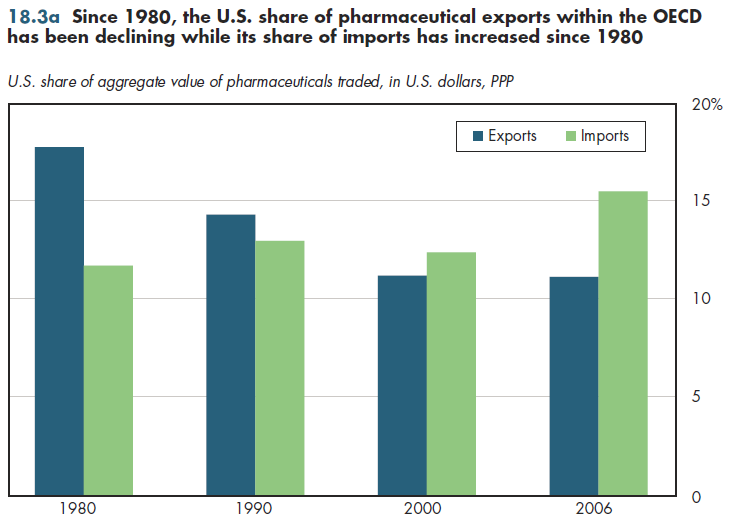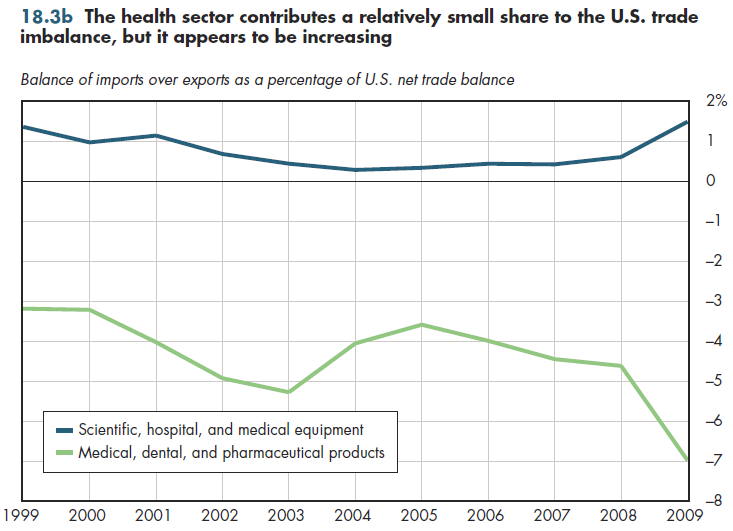Download PowerPoint versions of both figures.
Inside Collection (Book): American Health Economy Illustrated
18.3 US Accounts for a Relatively Small Share of Pharmaceutical Exports
Summary: Despite its global dominance in pharmaceutical R&D, the United States accounts for a small share of pharmaceutical exports among industrialized nations. Conventional measures of U.S. trade provide an incomplete picture of the contribution of the health sector to imports, exports, or the country's overall balance of trade.
U.S. dominance in pharmaceutical research is not mirrored in its shares of pharmaceutical exports. Not only is this share small—approximately 10 percent in 2006—but it has declined considerably since 1980, when it was closer to 20 percent (figure 18.3a). The United States likewise accounts for a modest share of imports—approximately 15 percent (compared with 45 percent of global pharmaceutical sales accounted for by those who live in the United States).

Measures of exports and imports are based on the location of the manufacturing facility, regardless of ownership. The approximate 10 percent export share in 2006 does not imply that U.S.-owned firms supplied 10 percent of pharmaceutical products purchased by other nations. Nor does it mean that U.S.-owned firms accounted for 10 percent of pharmaceuticals exported because some foreign-owned firms (for example, GlaxoSmithKline [GSK]) have U.S.-based manufacturing facilities. It simply refers to the share of pharmaceutical products manufactured on U.S. soil that cross country borders.
Health-related goods and services play a much smaller role in the U.S. trade imbalance than they do in the entire economy. In 2009, the U.S. trade imbalance (excess of imports over exports) exceeded one-half trillion dollars (figure 18.3b). Pharmaceutical, medical and dental products accounted for approximately 7 percent of this total. This was offset by a trade surplus in scientific, hospital, and medical equipment that reduced the trade imbalance by less than 2 percent. Thus, the health industry overall accounted for approximately 20 percent of the most recently measured trade imbalance.

For the limited time for which such detailed statistics are available, it appears that this share is increasing. This scenario of trade involving the health care sector is not complete. Medical tourism, for example, appears to be a rapidly growing industry. Its magnitude is not large enough yet to warrant separate tracking by the U.S. government.
Downloads
References
- Author's calculations.
- Department of Commerce. Bureau of Economic Analysis.
- Organisation for Economic Co-operation and Development.
Collection Navigation
- « Previous module in collection 18.2 US Accounts for More than Half of World Pharmaceutical R&D Spending
- Collection home: American Health Economy Illustrated
- Next module in collection » 19.1 US Health Spending Appears to Provide Good Value for the Money
Content actions
Give feedback:
Download:
Add:
Reuse / Edit:
Twin Cities Campus:
- © 2012 Regents of the University of Minnesota. All rights reserved.
- The University of Minnesota is an equal opportunity educator and employer. Privacy
- Last modified on Sep 27, 2013 2:06 pm -0500









